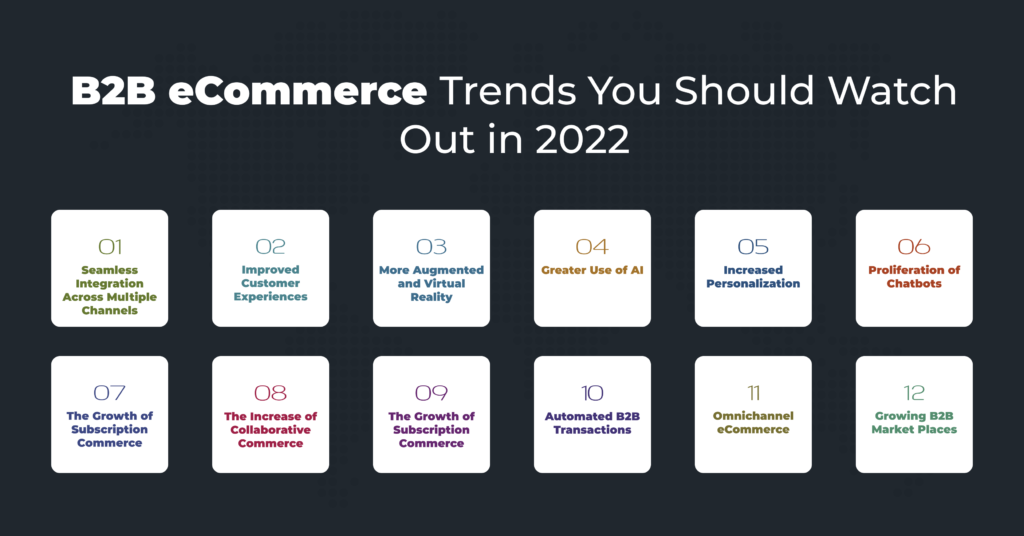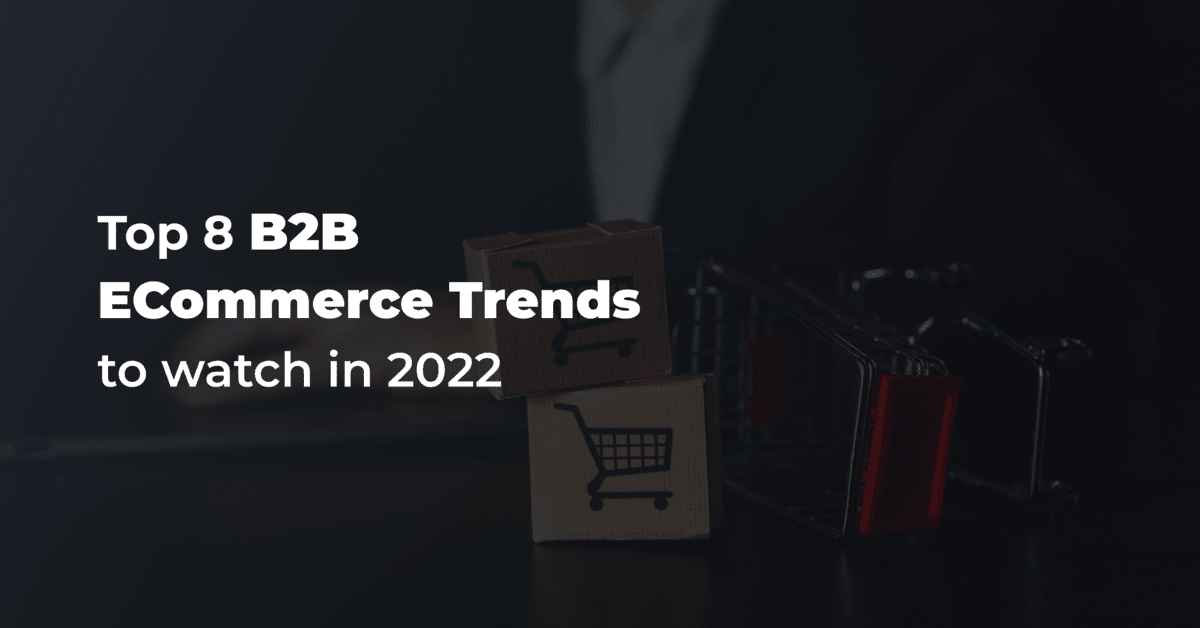eCommerce is booming and it’s showing no signs of slowing down.By the end of 2022, it’s estimated that B2B eCommerce will make up 54% of all B2B sales worldwide.
What’s driving this growth? You guessed it – the rise of digital shoppers. And with digital shoppers coming in new and different shapes and sizes, b2b ecommerce is experiencing a transformation that has never been seen before
This shift to digital purchasing is being driven by the ongoing pandemic, which has forced businesses to reevaluate their brick-and-mortar operations. It’s also being driven by the younger generations of workers who are comfortable buying online and conducting business digitally.
As we move into 2023, there are several B2B eCommerce trends that businesses need to be aware of. From the rise of marketplaces to the increasing importance of customer experience, these trends will have a major impact on the way businesses operate.
To stay ahead of the curve and ensure a successful b2b eCommerce experience in 2022, keep reading for our top 8 B2B eCommerce trends to watch in 2022!
Contents
What are the Most Important Trends to Watch for When Developing B2B eCommerce Strategies?

When it comes to designing and developing an eCommerce strategy for your B2B business, it’s important to stay up to date on new marketing trends. This means that you keep a close watch on social media platforms, eCommerce platforms, and mobile apps to see what’s popular and being used by customers.
You should also pay attention to customer needs and wants.
Right now, customers are looking for personalization and customization in their buying experience. This means that you need to think about how you can meet the customer’s needs in a way that makes sense for your business.
Another trend that businesses should be aware of is the growing role of digital channels in eCommerce. The internet has made it easier than ever for customers to interact with businesses, regardless of where they are located. This includes online shopping, social media, email, and phone calls.
As digital technology continues to evolve, so too will ecommerce strategies for B2B businesses. Blockchain and artificial intelligence (AI) are two technologies that are expected to have a significant impact on ecommerce in the future.
Read more: Top 8 eCommerce Challenges You Must Tackle in 2022 to Streamline Growth
Here is a detailed account of top 8 trends that are driving B2B distributors to succeed in the ever transforming marketplace:
1. Seamless Integration Across Multiple Channels
In today’s multichannel world, businesses must provide a consistent and seamless customer experience across all touchpoints. This includes everything from your website and social media to brick-and-mortar locations and mobile apps. All of these channels must work together to provide a cohesive customer experience.
To achieve this, businesses need to have a robust integration solution platform that can support all of their channel data to work from a centralized system without duplicating the efforts. It should also be easy to use and manage so you can make changes quickly and efficiently.
ERP, eCommerce, CRM Integration Tip: DCKAP Integrator enables distributors seamlessly connect systems together by controlling data flow across applications in response to changing business needs. Make changes without waiting for a developer to intervene. Keeping all of your systems up to date. Once you outsource the integration task to DCKAP Integrator, no further manual synchronization is required.
2. Improved Customer Experiences & Personalization
As the competition continues to increase, businesses must focus on providing an outstanding customer experience. This means creating a seamless and personalized experience for each customer, whether they’re shopping online, in-store, or both.
Personalization is one of the most important trends in eCommerce right now. Customers expect a personalized experience when they interact with businesses, and those that don’t provide it are at a competitive disadvantage.
To do this, businesses need to have a clear understanding of their customers and what they want. They then need to use this data to create personalized experiences that address their needs. This could include everything from tailored product recommendations to customized messages and offers.

Customer Experience Improvement Tip: It’s no wonder that personalized product recommendations based on previous purchase data, tailored content, creating targeted promotions and offers, sending abandoned cart reminders, automated data flow and customer specific pricing can help you improve total customer experience. Moreover, having a website with easy site navigation features, along with voice enabled search and live chat support are crucial to be ahead.
3. More Augmented and Virtual Reality
Augmented reality (AR) and virtual reality (VR) are two technologies that are starting to have a big impact on eCommerce. By incorporating augmented reality into your presentation, you can visualize and emphasize the areas of your offer that deserve special attention in the most realistic and engaging way possible. It is particularly handy for showcasing industrial machinery and similar products that your customers may want to visualize in detail. IMoreover, providing visualization capability makes it simpler to study data and absorb the insights it delivers. These technologies can be used in a number of ways, such as:
-Allowing customers to “try on” products virtually before they buy them
-Giving customers a 360-degree view of products
-Providing interactive product demonstrations
-Allowing customers to take virtual “tours” of your store or warehouse
What to Expect?
Prospects may explore sophisticated, huge, or spatially oriented B2B items as far as they want using AR solutions, all without burdening salespeople. Moreover, it enhances the ability for prospects to witness real-time product demos from any location leads to exciting cross-sell and upsell chances that salespeople would otherwise struggle to fulfill. And on the marketing front, It shortens the sales cycle, conveys product value early and frequently, and assists prospects in gaining internal consensus faster. Prospects are left with a lasting, pleasant image as a result of all of this.
4. Greater Use of AI
Artificial intelligence (AI) is another technology that is starting to have a big impact on eCommerce. AI robots and algorithms will help B2B marketers to collect and organize more data in order to properly evaluate the operation of their existing business network, which includes customers, suppliers, partners, distributors, and marketers.
Marketers will be able to touch all domains of brand marketing through 360-degree navigation of clients’ behaviors, inclinations, impulses, unique attitude, and purchasing patterns, from forecast to customisation. As a result, artificial intelligence in B2B marketing can assist:
- Anticipate prospective customers by predicting what customers want and need
- Generate insights from data and recommend products or services to customers
- Make a distinction between purchasers and visitors.
- Determine unique trends and Detecting fraud.
- Personalize various online campaigns
- Improve lead generation
- Increase your sales and revenue.
What to Expect?
Thus, AI enables marketers to forecast future results based on past performance. Furthermore, it segments and analyses the context of consumers’ inquiries and behavior using its capacity to understand natural language. This implies that AI can notify sales representatives if symptoms of discontent are identified. In a nutshell, AI will push the limits of creativity, creating dynamic user experiences that will enhance corporate income.

5. Proliferation of Chatbots
When a visitor makes an activity on your website , you should be responsive in your answers. The sooner you respond to the prospect’s questions and concerns, the better reputation you will gain among your customers.
Chatbots are computer programmes that simulate human conversation. They are often used to provide customer service or support on websites and messaging platforms. Real-time involvement is essential for building demand. You want to capture website visitors when they are most receptive, such as when they are on a certain product page or after spending a given amount of time on your website.
Chatbots are ideal for converting bot visitors-to-sales , informing your visitors that someone is accessible for a live chat when they’re ready for the next step.
Your chatbot may launch a chat based on a visitor’s behaviors and then pull your sales staff into the conversation. Reps can tailor the chat based on the visitor’s surfing history and purchasing indications.
Chatbots can be very useful for eCommerce businesses, as they can:
- Answer common customer questions quickly and easily
- Guide customers through the purchasing process
- Upsell or cross-sell products and services
How to benefit from using a chat box?
Considering that 83% of internet buyers claim to need help placing their orders. And 75% of the clients anticipate assistance within five minutes, a chat bot can come to your assistance to bring real-time interaction. Every interaction you have with a consumer may teach you something, and with time, you’ll get wiser. Additionally, you can quickly distinguish between different conversational kinds (sales, customer support, etc.) and direct a particular conversation to the appropriate departments or agents.
Recommended Reading: 7 Ways Distributors Can Boost Profitability: By Simplifying Their Commerce
6. The Growth of Subscription Commerce
Subscription commerce is a type of eCommerce where customers pay a recurring fee for access to products or services. This could be anything from grocery deliveries to streaming services like Netflix. The subscription model is growing in popularity because it’s convenient for customers and provides predictable revenue for businesses.
In order for businesses to succeed with subscription commerce, they need to focus on creating long-term relationships with their customers. This means providing outstanding service and continuously adding value over time. They also need to make it easy for customers to sign up for and manage their subscriptions.
Why you should look forward to the subscription model: Subscription memberships that personalize the consumer experience boost client retention and revenue development. This global move toward subscriptions is being driven by growing customer demand and post-pandemic expectations for faster, simpler digital purchases. Businesses with subscription-based models exhibited resilience even during a crisis such as the pandemic, demonstrating that these services are useful to a business even during a worldwide epidemic.
7. The Increase of Collaborative Commerce
Collaborative commerce is a type of eCommerce where businesses work together to provide goods or services to customers. This could include anything from manufacturers selling directly to consumers (i.e., bypassing retailers) to businesses partnering with each other to jointly develop and market new products. The goal of collaborative commerce is to create a more efficient and effective way of doing business by eliminating intermediaries or middlemen.
In order for businesses to succeed with collaborative commerce, they need to focus on developing trust and transparency with their partners. They also need to have efficient systems in place so they can quickly respond to changes in the market or supply chain. The new metaverse model will augment a collaborative 3D space that will bring a personalized experience to trade and succeed.

Make it Work For You: Collaborative Commerce is all about collaborating with consumers, suppliers, channel partners, and even rivals to provide more value to your customers.
- Sell directly to clients by collaborating with your network of distributors, dealers, or franchisees to provide hassle-free purchasing.
- Enable drop-ship partners and create your own online marketplace to sell third-party items that generate extra income without incurring inventory costs.
- Sell on Amazon or convince competitors to sell on your own online marketplace to provide customers with even more buying possibilities.
8. Explore Social Commerce
48% of B2B technology buyers refer to Facebook as they make ‘final decisions’ according to Social Pilots 2019 report. The rise of social media has led to a new generation of e-commerce businesses that are not afraid to be social. These companies use social media to connect with customers, answer questions and provide customer service.
E-commerce store owners often have a difficult time getting their products in front of customers because they don’t have enough budget for traditional marketing campaigns. But social media isn’t just about marketing — it’s also about enabling interaction with your customers, which is a lot more valuable than a one-time sale.
Here are three ways you can use social media to help grow your e-commerce business:
Create an online community around your brand: When people join a community like Facebook or Twitter, they’re usually looking for other users who share similar interests or concerns. If you’re running an e-commerce business, this can be especially helpful if you sell products that require assembly or customization — like furniture or custom clothing — because it gives potential buyers an opportunity to interact with other people who may be interested in their project.
Connect with other businesses in your industry: Connecting with others in your industry is another great way to reach out and connect with potential new customers — especially ones who might not be aware of what you do yet but could become interested down the road. Make sure that any connections you make are genuine, though; don’t just create accounts for the sake of creating accounts!
Share helpful content on social media platforms like Facebook and Twitter.
Sharing helpful content on social media platforms like Facebook and Twitter is another way for you to reach out and connect with potential customers who are already aware of what you do
Answer questions on social media: When people ask questions about your products on social media platforms like Facebook, Twitter and Instagram, it’s important that you respond directly from your own accounts instead of from customer service reps or automated responses.
Is this Social buzz going to stay?
As customers become more reliant on social media to influence their purchase decisions, social commerce is becoming increasingly crucial for B2B enterprises. This change to a more omnichannel approach entails ensuring that your company is accessible wherever your clients are. The goal is to capitalize on your relationships with social media influencers and other online channels by offering relevant material that assists them in growing their audiences and attracting new ones.

Relevant Reading: Why Ecommerce Automation Is The Next Big Thing For B2B Distributors
Integrate Right Technologies to Stay Ahead
There’s no doubt that B2B eCommerce is on the rise and is set to become even more important in the coming years. In this blog, we have outlined some of the key reasons why B2B eCommerce is booming and what you need to do to ensure success in this arena. From understanding customer needs to building a strong eCommerce foundation, we have covered everything you need to know to navigate this rapidly-changing landscape. Make sure to check back regularly for updates and insights on B2B eCommerce!
Incorporating AI and chatbots, integration software, & PIM solutions into your B2B ecommerce strategy is a great way to stay ahead of the competition. By using these technologies, you can help automate customer service processes and improve engagement levels between buyers and sellers. Additionally, nowadays ecommerce has also come to encompass services, which means that you need to focus on offering a seamless customer experience when purchasing anything from a seller.
You don’t need to worry! If you have the assistance of the best eCommerce solution providers, you will stay ahead of these trends. At DCKAP, we will help you get the best eCommerce solutions to streamline your eCommerce store. Get in touch with us to know more & grow digitally.




